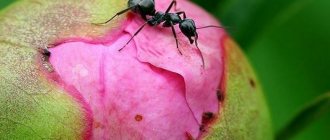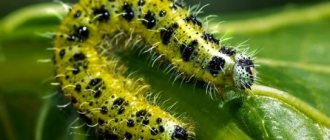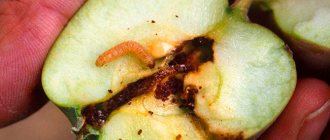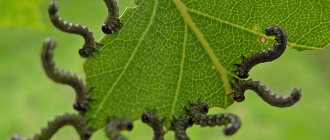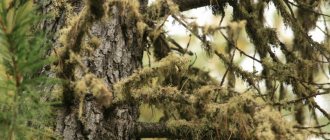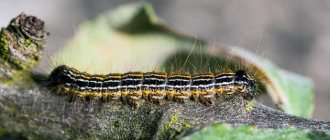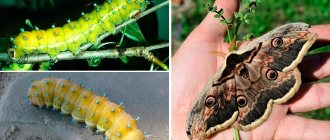Roses, rightfully considered the queens of any garden, can decorate any plot or flower bed. It is very annoying when, in the midst of fragrant flowering, they are subjected to a massive attack of pests.
Among the insects that attack rose bushes, green caterpillars are quite common. They not only spoil the decorative appearance of the plant, but can cause great harm and even cause the death of the plant. It is important to know how to combat these parasites and prevent their massive invasion.
Caterpillars can ruin the appearance of a rose
Causes
Caterpillars may appear on roses as young shoots or leaves emerge. Depending on the climate of the area where flowers are planted, this occurs from May to June. They are usually the larvae of the roseate leaf roller. These butterflies begin to fly in the spring, when the air temperature reaches +15 degrees. Within 2 weeks they lay eggs, from which caterpillars emerge at the end of May, causing harm to the plant.
The main reason why rose bushes are damaged by such pests is considered to be the wrong choice of planting site.
Green caterpillars prefer flowers that grow in the shade or in a place with high humidity. If the rose is located on the sunny side of your site, the risk of butterfly larvae appearing on it will be significantly reduced. Sometimes no more than 5-10 individuals can be seen on flower bushes, and in some years their number reaches such a figure that the plant becomes completely covered with them.
Weather conditions can also affect their occurrence and abundance. Frequent rains create a favorable environment for plant pests. The larvae of many insects spend the winter on bushes, so mild frosts and relatively calm weather cause many caterpillars to appear. With the onset of spring, you need to inspect old rose bushes in order to promptly eliminate the problem that could lead to their death.
Signs
To preserve the beauty of a rose, you need to pay attention to its appearance. If you notice sudden changes, this may indicate the presence of pests.
The main signs of damage by green caterpillars:
- the appearance of holes on the leaves. Subsequently, they undergo severe deformation or only veins remain;
- rose buds lack pistils and stamens;
- the flower petals are badly chewed;
- As the caterpillars stay on the rose for a long time, it begins to weaken due to lack of nutrients and loses its presentation.
Leaf roller larvae entwine leaves and flower petals with a web, forming a shelter for themselves in order to pupate.
All leaves with cobwebs should be removed to prevent the emergence of a new generation of pests.
Treatment
The first thing you should do when you find caterpillars on a flower bush is to pick them off with your hands. If there are too many of them, you can save roses from the pest by spraying the plant with products prepared according to folk recipes:
- burdock solution. To prepare the product, fill a third of the bucket with the leaves of the plant, fill it to the top with water and leave for 3 days;
- nightshade decoction. Place 5 kg of crushed plant leaves in a bucket and fill them with 10 liters of water. The product must be boiled for 4 hours, then strained and added 4 liters of water. After cooling, the decoction is ready for use;
- wormwood decoction. 1 kg of plant is poured into 3 liters of water and boiled for 10 minutes. After this, add another 7 liters of water to the decoction and leave the product to infuse for 10 days. Wormwood has good antiseptic properties and this helps repel pests from the rose;
- mustard. It can be used to sprinkle the top layer of soil around the bushes, which will prevent green caterpillars from climbing onto the plant from the ground. Prepare a mustard solution by adding 100 g of its powder to 10 liters of warm water. The product is thoroughly mixed so that the mustard dissolves as much as possible. Then it is sprayed on the rose bushes, leaving them in this state for at least 3-4 hours. The best effect is achieved when the solution is left on the plant for 24 hours. This method is used by many flower growers and gardeners because of its 100% effectiveness.
When treating plants with folk remedies, you must not forget about protective equipment, since some of them are poisonous. If it comes in contact with the skin or inside the body, a person may develop an allergic reaction or severe poisoning.
It is not enough to use folk remedies once, so if necessary, repeat the procedure after 2-3 days.
Insecticides should be used only if there is no effect and the caterpillars continue to eat rose bushes.
The main thing when it comes to treatment is time. Start treating the plant at the first sign of pests or at least one green caterpillar on the leaves or buds of the rose.
Adviсe
In order for the pest control products used to be more effective and not cause harm, flower growers are advised to follow certain rules:
- To apply solutions to rose bushes, you need to spray the plant from all sides with small sprayers that create a fog effect. This will eliminate the larvae that are hiding under the leaves or buds by covering the affected area with a medicinal liquid. If jet sprayers are used, the solution released will knock down a number of caterpillars and then flow to the ground;
- if there is an excessive number of pests, it is better to use chemicals;
- treatment of the plant should be carried out no earlier than the air temperature reaches +15 degrees;
- use protective equipment (glasses, gloves).
Flowers with hard leaves are less likely to be damaged by caterpillars, so they are more preferable for growing. You need to choose a place with enough heat and light. This will not only reduce the risk of pests, but will also have a beneficial effect on plant growth.
Caterpillars
With an abundance of these pests, the flower does not receive too many nutrients from the soil. The plant is weakening. In addition, waste products of the roseate caterpillar contribute to leaf rotting and the appearance of fungal diseases.
Under the influence of these caterpillars, the appearance of the entire bush changes. First the leaves begin to curl, then they turn yellow and fall off. The buds stop developing, and the petals begin to fall from the blossoming flowers. Then active leaf fall begins and flowers fall, and then the death of the entire bush occurs. Flowering will not be lush, as in the photo of healthy plants.
Consequences
When caterpillars settle on a flower, they begin to eat its leaves and buds. This significantly spoils the appearance of the roses. They lack essential nutrients, become weak and lose their beauty. The buds become small and pale, the leaves become deformed or only veins remain. For people who grow flowers for sale, this causes great material damage.
In the absence of timely actions to eliminate pests, the risk of the plant being affected by various diseases increases. An excessive number of caterpillars in a short period of time causes the death of roses.
How to get rid of and how to treat roses from caterpillars
The caterpillar settles on rose bushes to feed on rose buds and leaf pulp. This insect leaves large holes in the leaves, making it difficult for the plant to receive nutrients. As a result, it either becomes severely deformed or becomes weak. And aphids settle in entire colonies not only on the leaves, but also on the shoots and buds, sucking out the juice, which causes the plant to weaken and lose its beauty. You can protect roses from aphids and caterpillars by various means - both chemical and herbal.
The question arises: why do green caterpillars and other pests appear in the first place?
It is necessary to carefully select the landing site. In a damp place and shade, insects will appear on the bush faster than in a sunny place. Make sure that the leaves, stem - everything is green. If the plant begins to wither, check immediately for aphids, caterpillars and other bugs to prevent the problem from spreading.
Treatment with chemicals
In order to defeat the green caterpillar, especially if the insect can no longer be collected by hand, it is best to spray the bush with chemicals. When going to the store for insecticides, remember that you need preparations specifically for roses. Look for packages with special markings. The following methods are considered the most effective:
- "Spark";
- "Inta-Vir";
- "Karbofos";
- "Aktara";
- "Fitoverm";
- "Decis".
Read the instructions carefully before use
Before spraying roses, all precautions must be taken. Spraying must be done once every 12 days.
More detailed information can be found in the instructions for each of the listed drugs. Do not overuse chemicals - it will take time for the insects to die.
Treatment with herbal preparations
There are caterpillars on your roses, but you don't want to use chemicals? Then resort to traditional methods. The simplest thing you can do is collect insects with your hands. But this will have to be done constantly, since new individuals will not keep you waiting long. There are actually different safe ways you can get rid of caterpillars.
You can use the most ordinary mustard - however, such treatment can harm not only insects, but also the rose bush. Mustard is poured with warm water. The entire plant is treated with the mixture and left for 3–4 hours, or better yet, 24 hours. Or sprinkle mustard near the bush - this should repel potential pests.
Let's look at other folk methods. For example, prepare a solution of burdock. Fill the bucket one third with leaves and fill it to the top with water. The product will be ready for use in three days. However, this is not the last way to get rid of the annoying pest. If you manage to find nightshade (plant), then you can get another herbal remedy. So, you will need 5 kg of leaves. Fill them with 10 liters of water and boil for 4 hours. Strain the resulting solution and add another 4 liters of water - and your new weapon against caterpillars and aphids is ready.
The question often arises: “How to treat roses as a preventive measure?” Wormwood is an excellent antiseptic. Boil 1 kg of herb in 3 liters of water for 10 minutes. Gradually pour in another 7 liters of water and leave the mixture for 10 days. With this tool we fight potential enemies.
Note that folk remedies do not always give quick results. Even if your neighbor tried one method or another, but it didn’t work, it’s still worth a try. Use chemicals last.
The main thing is not to delay so as to have time to save the rose. Pests multiply very quickly, and aphids immediately settle in a whole squad on the bush. As soon as caterpillars appear on roses, immediately look for something to treat from what you have in the house. Collecting pests is safer for your own health than spraying, but it is ineffective if there are too many insects.
Disadvantages of Chemical Treatment
It is not recommended to use chemicals in gardens because:
- this makes it impossible to use rose petals in cosmetics and cooking;
- the insecticides used are dangerous for other plants growing nearby;
- Pests become addicted and the products become ineffective.
The best results come from environmentally friendly products that need to be alternated periodically. They are quite effective, safe, and provide complete elimination of aphids. There is always the possibility of selecting the most appropriate substances and processing methods that will provide a quick, sustainable result.
Watch the video! The best remedy for aphids!
How to get rid of caterpillars using folk remedies
Folk methods for killing caterpillars
Many gardeners try to use folk remedies for caterpillars on fruit trees because they are safer.
- Red elderberry. Pest caterpillars cannot tolerate the smell of elderberries. It is enough to prepare a decoction using the stems and leaves of the tree. 200 g of crushed raw materials are poured into 10 liters of boiling water. After 24 hours, the mixture is filtered. To better fix the infusion with the surface of the leaf, add laundry soap grated on a coarse grater (40 g). The resulting composition is used to spray trees before and after flowering.
- Henbane black. A decoction of black henbane is no less effective against voracious pests. To prepare it, you need to chop 2.5 kg of tree branches and leaves, pouring them with a small amount of water. The mixture is boiled for half an hour. The resulting volume is brought to 10 liters, turning off the heat after the mixture boils. The broth is infused for 12 hours, filtered and laundry soap is added by analogy. The prepared decoction should be sprayed onto an insect-infested tree.
- Red pepper. Red pepper, or rather a tincture of it, will help get rid of black hives caterpillars in the garden. 1 kg of raw material is poured into 10 liters of water and boiled for an hour, after which it is infused for 24 hours. The concentrate is stored in the refrigerator. Before treating plants with it, the composition is diluted with water in a ratio of 12 g of infusion per 10 liters of water. To increase the fixing properties, add 40 g of laundry soap to the composition.
- Vinegar. Flowers affected by butterfly larvae can also be treated with a vinegar solution. It is prepared at the rate of 200 g of vinegar per 10 liters of water.
- Onion and garlic. Pests do not like the aroma of plants rich in essential oils. These include garlic, onion and coriander. It is enough to plant such plantings among vegetable beds and insects will not damage the crop.
- Tobacco. Tobacco infusion can also protect the crown of trees from caterpillars. 100 g of tobacco is poured into 1 liter of water and left for 24 hours. After this time, the mixture is filtered and 40 g of liquid soap is added to it. The prepared solution is used for its intended purpose.
- Peppery knotweed. A decoction of pepper knotweed is also effective in the fight against plant parasites. To prepare it, shoots of a flowering plant are used. 2 kg of chopped stems are poured into 10 liters of boiling water and infused in a closed container for 24 hours. The strained infusion is used for spraying garden crops.
- Pharmaceutical camomile. An infusion of chamomile inflorescences has similar properties. For 10 liters of water you will need 1 kg of chamomile flowers. The mixture is brought to a boil and left for 12 hours. Before use, the concentrate is filtered and diluted with water in a ratio of 1:3. To enhance the fixing effect, for every 10 liters of the finished solution, add 40 g of laundry soap grated on a coarse grater.
- Tomato tops. Tomato tops are very popular in the fight against various harmful insects; they are also effective against crawling leaf-eaters. The bucket is filled with slightly dried raw materials and filled to the top with water. The mixture is boiled for an hour, then filtered and diluted with water in a ratio of 1:5. The resulting solution is used to spray crops infected with caterpillars.
- Fumigation. Fumigation of fruit trees with smoke gives a good effect in the fight against various types of caterpillars. Hot coals are placed in a heat-resistant vessel, which are sprinkled with a mixture of resin and sulfur (the ingredients are taken in a ratio of 1:2). To kill the pests, it is enough to fumigate the trees in their lower part.
When crawling butterfly larvae appear on a plant, there is no time to waste, because the nests are inhabited by thousands of harmful individuals that can destroy leaves and young shoots. Affected trees and bushes should be immediately treated with one or another folk remedy.
Biological attack
Ants are one of the main causes of aphids. Black and red insects guard pests and carry them from one bush to another. To defeat the green bugs, you need to destroy the ants:
- Place pieces of double-sided tape or paper treated with non-drying glue around the rose bushes.
- Place bait with poison, for example, minced meat with brown or honey with boric acid.
- Treat ant trails with unrefined sunflower oil, elderberry or wormwood tincture. Scatter dry or fresh peppermint sprigs.
- Soak the soil around the bushes with essential oils. Suitable eucalyptus, mint and tea tree.
- Dust the roots of the plant with cinnamon or lavender powder. You can treat the soil with semolina or millet.
When the aphids have no defenders left, you need to attract ladybugs into the garden. Spotted insects like the smells of certain plants:
- dill;
- marigolds;
- tansy;
- calendula;
- clover;
- mustard;
- coriander;
- yarrow;
- sweet clover
It is not necessary to plant marigolds or tansy around roses. You can hang several branches of fragrant plants around the bushes and wait for the ladybugs to fly to the scent. Some gardeners specifically collect spotted insects and bring them to the site. If you plant at least one ladybug on a bush that has been attacked by green bugs, within 2-3 days there will be nothing left of the pests.
Aphids are destroyed by small songbirds: tits, linnets, robins, sparrows and wrens. Feathered hunters are lured by feeders with bread crumbs and grain, drinking bowls with water and birdhouses.
Chickadees and sparrows will clear roses of aphids and other harmful bugs in a matter of days. This method has a disadvantage, because birds, unlike ladybugs, eat all insects. Both bad and useful.
"Questions and answers"
Nightshade is a poisonous plant that must be handled with care when working. After spraying, ensure that children do not touch the treated plants.
Question No. 1. What features exist when treating roses for caterpillars?
It is better to use small sprayers and spray the bushes from all sides. During processing, the caterpillars hide on the underside of the leaf, in secluded forks of shoots, under the scales of the buds. This is why liquid mist is more productive than jet spraying. With strong pressure, the liquid knocks down only those tracks that it hits and immediately flows to the ground. When sprayed finely, the droplets completely “envelop” and destroy caterpillars even in hard-to-reach places.
Question No. 2: Is it better to choose bioinsecticides or chemicals?
It depends on many circumstances. For example, if there are small children in the family who like to touch and even chew beautiful plants, then it is better to use biological means.
When there are too many caterpillars, then you have to use chemicals, because gentle biological products cannot cope with a large number of pests.
Prevention
To reduce the likelihood of roses being damaged by such pests, it is recommended to take some preventive actions:
- hang traps throughout the area for butterflies, the larvae of which harm the flower. To do this, you need to glue small houses out of paper, into which sticky sheets soaked in pheromones are placed;
- After opening the roses, you need to carefully examine its stems. If masonry with bark is found, it is removed. When the caterpillars are located at the ends of the shoots, these areas are cut off and treated with copper sulfate;
- all plant remains must be burned off-site;
- Before the buds open, you need to spray the flowers with nitrophen, and in May - with bifenthrin.
Fungal disease of roses: powdery mildew and how to get rid of it
First, check out the photo and description of the rose disease powdery mildew, which develops due to a lack of calcium or dry soil.
Powdery mildew. A powdery coating appears on young leaves, shoots and buds; their thickening and curvature are observed.
Powdery mildew on roses is a mycelium and sporulation of the fungus. The causative agent of the disease overwinters in the form of mycelium in the kidneys. The development of the disease is facilitated by excess nitrogen fertilizer, lack of calcium in the soil, drying out of the soil, too light sandy or, conversely, cold, damp soils.
Look at the photos of powdery mildew on roses below:
Indoors, this disease of roses develops especially strongly in rooms with insufficient lighting and humid, stale air. Sudden changes in temperature, drafts, drying out of the soil in pots and other conditions that disrupt the normal life of plants reduce their resistance to disease. Tea and hybrid tea varieties with more delicate foliage are especially strongly affected by this fungal disease of roses.
How to get rid of powdery mildew on roses and prevent re-infection?
When the first signs of the disease appear, it is necessary to spray the bushes with: “Topaz”, “Fundazol” or “Skorom”. You can use the systemic drug "Raek" with long-term preventive and therapeutic effects.
Common mistakes
- The flowers and leaves of the roses began to dry out and fall off. As a rule, this effect appears when pest control is carried out under bright sun.
- Over time, the aphids do not respond to the poison. It is recommended not to use the same method, but to alternate treatments in different ways, because the insect adapts to the poison over time.
- After treatment, aphids still appear. The thing is that almost all methods are aimed not at prevention, but at combating aphids that have already appeared. Unfortunately, only chemicals can combat both adult insects and the eggs they lay.
Folk remedies
If your rose is being eaten by caterpillars, you need to act quickly. A large colony of pests can destroy a flowerbed in a few months. You can treat roses against caterpillars with folk remedies at any time during the plant’s growing season.
- Mustard powder. Sprinkle the paths in the flowerbed, and also use mustard to prepare the solution. Add powder and a little laundry soap to the water. Spray the leaves. Properties last for several days in dry weather. If pests are detected again, repeat spraying every 3 days.
- Ash. The fight against black caterpillars on roses is not complete without wood ash. The same remedy saves flowers from aphids, leaf roller larvae and many other pests. Ash is sprinkled on the soil in the flower bed and watered abundantly. The active components penetrate the plant juice, making it bitter and unattractive to caterpillars. A solution with the addition of laundry soap and ash is sprayed onto the leaves. The product irritates the skin of the larvae, causing them to leave the plant.
- Sagebrush. The poisonous plant not only repels the larvae with a persistent odor, but also leads to death. 1 kg of wormwood is poured into 3 liters of water, boiled over low heat for 20 minutes. Let it brew for at least 2 hours. Spray the bush and water the soil.
You need to systematically fight caterpillars using folk remedies. If the flower bed is heavily infested, one time will not be enough. Folk control methods are the same for vegetables, shrubs and trees. The recipes for killing pests on cabbage, plums or roses are the same.
To reduce the number of larvae, they are collected by hand. They repel with a solution of table vinegar, ammonia, boric acid, tobacco, garlic tincture, ordinary soapy water with added salt, baking soda. You can get rid of pests with live plants by planting calendula, marigolds, and peppermint nearby.
Attract beneficial insects to your garden
The fewer chemicals you use in the garden, the more beneficial insects that destroy pests will help you. The most popular helpers are ladybugs, which feed on aphids, scale insects, psyllids, butterfly eggs, and small caterpillars. One insect can eat up to 200 pests per day! Moreover, the insect larva also has an excellent appetite. To attract a ladybug, it is enough to plant yarrow, fennel, calendula, tansy or cornflowers in the flowerbed.
Other insects will also protect roses from pests: fire beetles, garden ground beetles, earwigs, lacewings.
Bugs in the garden: how to distinguish beneficial insects and how to deal with harmful ones Find out which insects on the site should not be destroyed.
It is also worth attracting birds, hedgehogs, toads, and frogs to the garden. They will protect not only rose bushes, but also other plants on the site.
How to attract living helpers to the garden? Don’t know how to fill your area with life and attract beneficial insects and birds? To do this, just follow a few tips.
Caterpillars on roses: how to treat them
Leaf roller caterpillars lay eggs in the autumn. To do this, they choose places under the bark of a tree, in an old stump or in layers of leaves. The eggs hatch into small green-brown caterpillar larvae. This happens at the beginning of spring. One clutch of such caterpillars will produce a couple of hundred eggs, which poses a serious threat to roses.
Important! The leaf roller larva goes through various stages of development. She grows up in 2 months
Early spring is a period when the likelihood of pests appearing in flowers is high. In May-June, pests begin to attack flowers, then pupae emerge from the caterpillars, from which butterflies then emerge.
What chemicals help fight caterpillars?
Gardeners control caterpillars in different ways. Garden supply stores offer chemicals of various effects. They can easily deal with the larvae and help avoid repeated attacks by parasites. It is best to treat roses against pests in the morning or evening when the weather is dry.
If there are green caterpillars on roses, what is the best treatment:
The drug is nitrophen. To rid plants of parasites at the beginning of their appearance, in order to reduce the degree of damage to roses, they are sprayed. For this, a nitrophen solution is used. This procedure is done with the onset of early spring. This remedy will be effective when the larvae are just beginning to appear. It neutralizes a repeated attack for about 2 months. For treatment, dilute 300 ml of the substance in 10 liters of cold water. The resulting solution should be sprayed on all roses and nearby crops. To do this, you should take a watering can, a spray bottle or a spray bottle. The main thing is to carefully read the description of the drug so as not to harm the flowers.
- Aktara is an insecticide and has broad effects. To rid rose bushes of caterpillars, one treatment with this product will be quite enough. Actara penetrates into the leaf plate. This approach allows you to withstand exposure to rain and high ambient temperatures. The substance lasts approximately 30 days. To protect the flower bed from pests (aphids and caterpillars), the chemical is used as follows: 8 g of the drug is diluted in 10 liters of water. If necessary, after a month you can re-spray the roses against the leaf roller caterpillar.
- Actellik is a professional means of exterminating pests of indoor and garden plants. Treatment with this drug can be carried out regardless of the growing season. Preventive spraying of rose bushes is done in May or with the onset of June. The effect of the drug lasts about a month. The strongest effect occurs during the first 2 hours. To prepare the solution, 2 ml of actellik must be dissolved in 2 liters of water.
Note! Biological products can also help control caterpillars on roses. The action of the active components of these products causes disruption of life processes in the body of pests
After 10 days they die. Treatment is carried out 2 times a month, as long as there is a risk of pests.
Reviews
Our caterpillars appeared simultaneously on the old rose bush and on the newly planted one. When I was a little one, I picked them with my hands, and the neighbors advised me to spray them with mustard when I was a little one. I carried out the procedure in the morning with a broom, and in the evening I bathed the roses in clean water. After 2 days, I repeated spraying with mustard and these pests did not appear again.
Maria, 29 years old, Voronezh
This summer I noticed that holes appeared on the leaves of roses. I examined the bush and found caterpillars. A neighbor in the country suggested a recipe for a remedy to combat them - a solution of burdock. We grow a lot of it, so collecting the leaves is not difficult. I sprayed the bushes 3 times and the problem was solved. Now every spring I inspect the stems so as not to miss their possible appearance.
Green caterpillars are very dangerous for roses, especially if you do not take steps to destroy them. To avoid damage to flowers by such pests, you need to choose the right place for planting them and do not forget about prevention. If you find them on the leaves and buds, immediately spray them with medicinal agents, because the beauty of roses largely depends on the timely provision of assistance to the plant.
What chemicals should you use to treat roses if caterpillars start eating them?
The fight against parasite infestations is carried out in different ways. Chemical solutions can be purchased at flower and garden stores. They easily destroy larvae and adult insects and help prevent repeated attacks by pests. Treatment is carried out in the morning or evening in dry and windless weather.
Chemicals are best used in the morning
If caterpillars are found on roses, how to treat them with chemicals:
- nitrophen. Recommended for use at the first sign of pests. Shrubs are sprayed with a solution of the drug from the first days of spring. The product shows maximum effectiveness when single larvae appear and prevents repeated attacks of parasites for 2 months. For the procedure, 300 ml of the substance is diluted in 10 liters of water, the resulting chemical is sprayed not only on roses, but also on nearby crops;
- Aktaroy. Refers to insecticides with a wide spectrum of action. The destruction of insects takes place after one full procedure due to the penetration of active components into the structure of the foliage. The mixture protects shrubs from rain and high temperatures, the effectiveness is maintained for one calendar month. For spraying, mix 8 g of actara in 10 liters of water. If the need arises, roses can be re-treated no earlier than 30 days after the first procedure;
- actellikom. Professional exterminator of indoor and garden pests. The procedure is carried out regardless of the growing season; for prevention, the bushes are sprayed at the end of May or beginning of June. The duration of action of the chemical is about a month, maximum effectiveness is observed during the first 2 hours. To prepare the solution, 2 ml of actellik is diluted in 2 liters of water.
Important! Biological agents can also be used to kill caterpillars. Their active components cause disruption of life processes in the body of parasites; after 10 days they die. Each bush can be sprayed only twice a month, the duration of the procedures is the entire period of possible pest attacks
Each bush can be sprayed only twice a month, the duration of the procedures is the entire period of possible pest attacks.
Fighting methods
Roses need to be inspected carefully as often as possible, preferably daily. When you discover parasites, you first need to think about how to deal with them. This is a long-standing problem, so there are many time-tested methods for solving it. You can remove pests mechanically - by collecting them with your hands or rinsing them off with a stream of water. This works when there are few aphids. You need to wear gloves and wipe off the insects, being careful not to damage the delicate tissue of the rose.
It is also easy to wash them off with water; only a strong stream of water can break the sprouts; you will have to carefully wash the bushes several times to ensure that the parasites disappear
If there are a lot of pests, then you need to treat the plants with special preparations. There are insecticides that can quickly get rid of aphids, but they can destroy other, harmless or even beneficial insects, so many gardeners prefer more gentle products that are made on the basis of herbal and other not too harmful products.
Folk remedies
Proven folk remedies offer not only to destroy or drive away, but also to prevent the appearance of aphids in the flower garden. There are plants near which aphids never appear because they cannot stand their smell. If marigolds, mint, lemon balm, sage, dill, and garlic grow nearby, then roses will never become acquainted with these parasites. Many owners simply place branches of these plants under roses. And at home, geraniums are placed next to roses to repel pests.
It is known that ants take care of aphids and carry them to new habitats, but lizards, lacewings, ladybugs and birds eat them in the thousands.
This means that you need to try to ensure that there are no ants on the site, but ladybugs can be specially brought in, birds can be welcomed with winter feeding and houses.
You can spray roses with infusion or decoction of nettle, mint, sage, geranium or other plants. Sometimes milk with iodine or water with soap and vinegar is used
It is important to alternate spraying agents so that pests do not have time to get used to them and adapt
Soap solution
Soap solution is used to combat a wide variety of harmful insects. Laundry soap is dissolved in water and roses are treated with this liquid every day for up to two weeks. Instead of soap, liquid soap detergents are sometimes used; preparing the preparation from them is much faster.
Decoction of tomato tops
It has long been noticed that aphids appear on roses simultaneously with the appearance of stepsons on tomatoes. The stepsons are collected, boiled for about 20 minutes, then cooled, filtered and sprayed on the roses and the ground around them. The smell of tomatoes repels not only aphids, but many other pests, and does not cause harm to surrounding plants, so this simple recipe is very often used in practice.
Garlic extract
Insects really don’t like the smell of garlic; just plant a few cloves in the flowerbed and aphids won’t disturb the flowers. But, if this is impossible to do, and insects have already attacked the rose garden, you can make a water infusion of garlic cloves, mix it with soapy water (to keep it on the stems and leaves longer) and treat the roses with this remedy. The treatment is repeated several times until the parasites are completely eliminated.
Potato soap solution
As soon as you notice the first colonies of aphids on plants, you can treat them with potato infusion. To do this, pour 1.5 - 2 kg of potato peelings with two liters of hot water, leave for at least two days, and filter. Add liquid soap or some kind of soapy detergent (or you can dissolve laundry soap) to this liquid and beat well. You need to treat the rose bush with this product. If the infection has just begun, the effect will be strong.
Tobacco or ash
Tobacco drives away aphids well; pests do not like its smell. You can place dry tobacco in a pot with a home rose; just sprinkle it on the ground before watering. Or you can make a decoction by boiling 10 g of tobacco in two liters of water, cool, strain, add liquid soap or detergent and treat the rose with all this. You can make an ash decoction, add soap to it, and this will certainly help defeat the parasites.
In a flowerbed, tobacco is sometimes set on fire and flowers are fumigated to drive away parasites; the tobacco must smolder, and the smoke must be directed toward the roses.
Main pests of roses
Late spring – early summer is the time of pest activity. Beetles and butterflies fly around the rose bushes, caterpillars and mites crawl around. Despite the formidable thorns, roses will quickly succumb to small pests if your favorite flowers are not helped. But before building a defense, you need to know the enemy by sight.
The most common pests of rose bushes:
aphids - tiny green creatures that actively suck the juice from the buds and young leaves of the rose;
- the descending rose sawfly, which gnaws passages inside the shoot, eating away its pulp;
- rose slimy sawfly (small green caterpillars) feeding on young leaves;
- rose leaf roller - a caterpillar that eats leaves down to the skeleton and rolls them into a tube, forming a shelter;
spider mite sucks juice from the bottom of the leaf. It spreads especially quickly in dry, hot weather. The mite itself is difficult to notice (its size is up to 1 mm), but if the leaves on the underside, shoots and buds are covered with cobwebs, it has definitely settled on the rose;
- The rose leafhopper, one of the smallest pests, is difficult to notice, but the results of its activity are immediately noticeable: it draws juice from the leaves and then eats its pulp. At the same time, it injects poisonous saliva into the plant. It has excellent jumping ability; in case of danger, it easily jumps from a disturbed plant to a neighboring one;
- beetles (weevils, bronze beetles, beetles, deer beetles) are quite large insects that eat away buds and flowers. They are especially attracted to their white and yellow flowers;
- Rose thrips are one of the most dangerous insects for roses. They pierce the leaves and petals and suck the juice from them. Due to their small size, they can only be detected by the spots left by their vital activity.
Resistant varieties
According to the advice of flower growers, it is better to plant varieties that have an increased ability to resist green caterpillars:
- Angela;
- Don Juan;
- Westerland;
- Knirps;
- Lucia;
- Scarlett;
- Like;
- Freesia;
- Schneewithchen;
- Yutersen.
Important! When growing any variety, there is a risk of caterpillars if the plant is planted in the wrong place.
How to spray roses against aphids and caterpillars?
Very often in spring and summer, roses are attacked by various pests that attack the plant, spoil its appearance, and sometimes even cause death. Such creatures harmful to the life of roses include, among others, aphids and caterpillars. Let's consider how they affect the plant and what are the effective measures to combat them.
Why are caterpillars and aphids dangerous?
Aphids, settling in entire colonies on the leaves, shoots and buds of the plant, suck the juice from the tissues. As a result, roses weaken, lose their former beauty, their leaves curl, and flowering may not occur at all.
Caterpillars, settling on roses, feed on rose buds and leaf pulp. They leave holes on the leaves, which make it difficult for the plant to receive the necessary nutrients. As a result, the roses become deformed and weaken.
Herbal sprays for aphids
The most common soap solution will help get rid of aphids. To prepare it you will need laundry soap. It should be grated and filled with water. After the soap has completely dissolved, the solution must be filtered, poured into a sprayer and treated with roses.
Another effective remedy against aphids can be prepared using nettle. To do this, add crushed dry nettle (200 g) to warm water (5 l) and leave until the solution begins to ferment (an average of 2 weeks). Spray the roses with the resulting liquid.
Spraying solutions prepared from young garlic shoots, onion peels, as well as tomato and potato tops have also proven themselves well in the fight against aphids. You just need to fill the raw material with tap water and leave for 24 hours.
Tobacco will also help eliminate aphids. It, in the amount of 500 g, needs to be filled with water (9 l) and boiled for half an hour. Dissolve a piece of laundry soap in hot water (1 liter). Mix both resulting liquids and spray.
Herbal sprays for caterpillars
A solution of burdock will help free roses from caterpillars. To prepare it, you need to fill a bucket 1/3 of its volume with burdock leaves and fill the container to the top with water. After three days of infusion, the product is ready for spraying.
A plant such as nightshade is also effective in the fight against caterpillars. You will need to collect 5 kg of leaves, fill them with water (10 l) and boil for 4 hours. Strain the resulting mass and add 4 liters of water to it.
A wonderful natural antiseptic called wormwood will keep caterpillars away from the rose garden for a long time. It is necessary to place wormwood (1 kg) in a large container, fill it with cold water (3 l) and cook for 10 minutes. Gradually pour in another 7 liters of water. Cool the resulting liquid and let it brew for 10 days, after which the product for spraying roses is ready.
Chemicals
If herbal remedies do not bring the desired result, and pests still continue to attack the plant, then there is nothing left to do but resort to the help of chemicals. When purchasing insecticides, you need to choose only those that are specially marked “for roses.”
Among the most effective means that help eliminate aphids and caterpillars, we can note such drugs as “Iskra”, “Intavir”, “Kar6ofos”, “Aktara”, “Fitoverm”, “Decis”. Before using any of these products, you must study its instructions in detail. Spraying is carried out once every 12 days.
Neighboring plants
There are plants that have a strong aroma. They are able to repel aphids, which cannot tolerate strong odors. Such green allies should be planted closer to rose gardens. This will help keep your roses safe and blooming vigorously.
Aphids repellent
Plants that help in the fight against aphids:
- sage;
- mint;
- dill;
- marigold;
- parsley;
- lavender;
- daisies.
These are common and unpretentious crops that are not difficult to plant on the site.
Attracting aphids
There are bushes and flowers that attract green midges like a magnet. It is better to plant them away from roses. Select a place in the distant flower beds.
Attract aphids:
- begonia;
- decorative poppy;
- petunia;
- nasturtium;
- mallow;
- cosmos.
Roses should not be planted next to viburnum, mulberry, linden or bird cherry.
